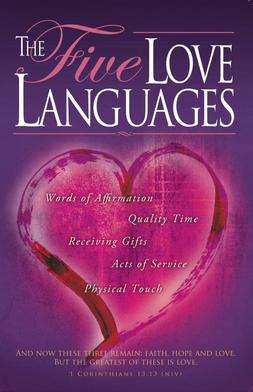The Five Love Languages
 | |
| Author | Gary Chapman |
|---|---|
| Original title | The Five Love Languages: How to Express Heartfelt Commitment to Your Mate |
| Country | United States |
| Language | English |
| Subject | Intimate relationships |
| Publisher | Northfield Publishing |
Publication date | 1995 |
| ISBN | 9781415857311 |
The Five Love Languages: How to Express Heartfelt Commitment to Your Mate is a 1995 book by Gary Chapman.[1] It outlines five ways to express and experience love that Chapman calls "love languages": receiving gifts, quality time, words of affirmation, acts of service (devotion), and physical touch.[2] Examples are given from his counseling practice, as well as questions to help determine one's own love languages.
Chapman's book claims that the list of five love languages is exhaustive.[3][4] According to this theory, each person has one primary and one secondary love language.
Chapman suggests that to discover another person's love language, one must observe the way they express love to others, and analyze what they complain about most often and what they request from their significant other most often. He theorizes that people tend to naturally give love in the way that they prefer to receive love, and better communication between couples can be accomplished when one can demonstrate caring to the other person in the love language the recipient understands. An example would be if a, he may be confused when he does the laundry for his wife and she doesn't perceive that as an act of love, viewing it as simply performing household duties, because the love language she comprehends is words of affirmation (verbal affirmation that he loves her). She may try to use what she values, words of affirmation, to express her love to him, which he would not value as much as she does. If she understands his love language and mows the lawn for him, he perceives it in his love language as an act of expressing her love for him; likewise, if he tells her he loves her, she values that as an act of love.
There has been a lack of research to test the validity of Chapman's model and whether it can be generalized. Egbert (2006) suggests that the Five Love Languages might have some degree of psychometric validity despite its abstract nature.[5]
The book has been on the New York Times Best Seller list since August 2009.[6] A new, revised edition of The Five Love Languages was released on January 1, 2015.
Related works
Since 1995, Chapman has written several books related to The Five Love Languages, including The Five Love Languages of Children in 1997 and The Five Love Languages for Singles in 2004.[7] In 2011, Chapman co-authored The 5 Languages of Appreciation in the Workplace with Dr. Paul White, applying the 5 Love Languages concepts to work-based relationships.[8] There are also special editions of the book such as The Five Love Languages: Military Edition, released in 2013, which Chapman co-authored with Jocelyn Green.
References
- ↑ Gary Chapman (1995). The Five Love Languages: How to Express Heartfelt Commitment to Your Mate. Northfield Publishing. ISBN 1881273156.
- ↑ Pam Farrel (2005). The 10 Best Decisions a Couple Can Make. Harvest House. p. 125. ISBN 0736934731.
- ↑ Stephen M.R. Covey; Rebecca R. Merrill (2006). The Speed of Trust: The One Thing that Changes Everything. Simon & Schuster. p. 212. ISBN 141654237X.
- ↑ Michael Olpin; Margie Hesson (2009). Stress Management for Life (2 ed.). Cengage Learning. p. 205. ISBN 0324599439.
- ↑ Egbert, Nichole; Polk, Denise (23 Aug 2006). "Speaking the Language of Relational Maintenance: A Validity Test of Chapman's Five Love Languages". Communication Research Reports. 23 (1): 19–26.
- ↑ "Paperback Advice & Misc. Books - Best Sellers - The New York Times".
- ↑ David Rainey (2008). Faith Reads: A Selective Guide to Christian Nonfiction. ABC-CLIO. p. 125. ISBN 1591588472.
- ↑ Chapman and White, Northfield Press (2011), Appreciation at Work network